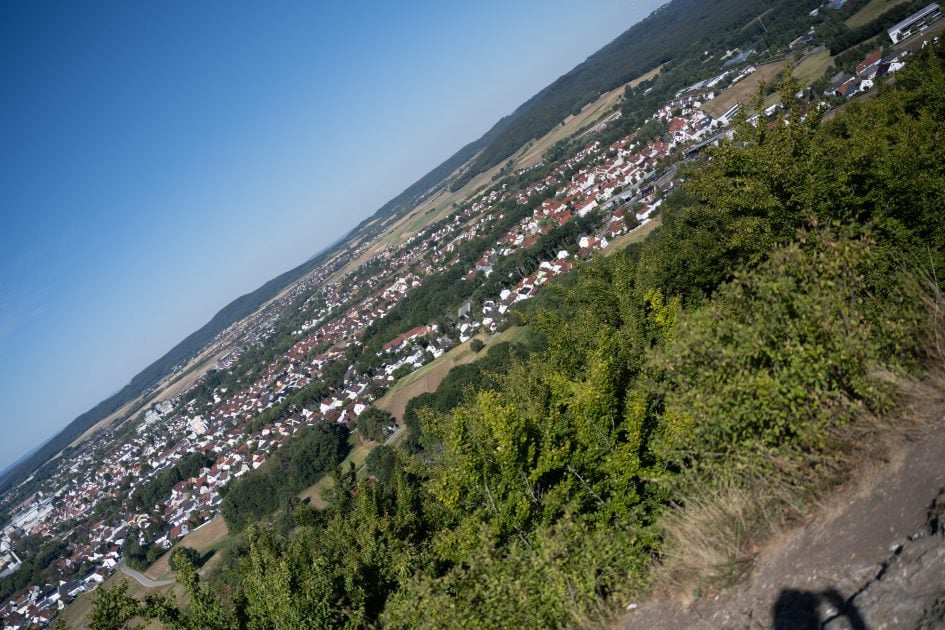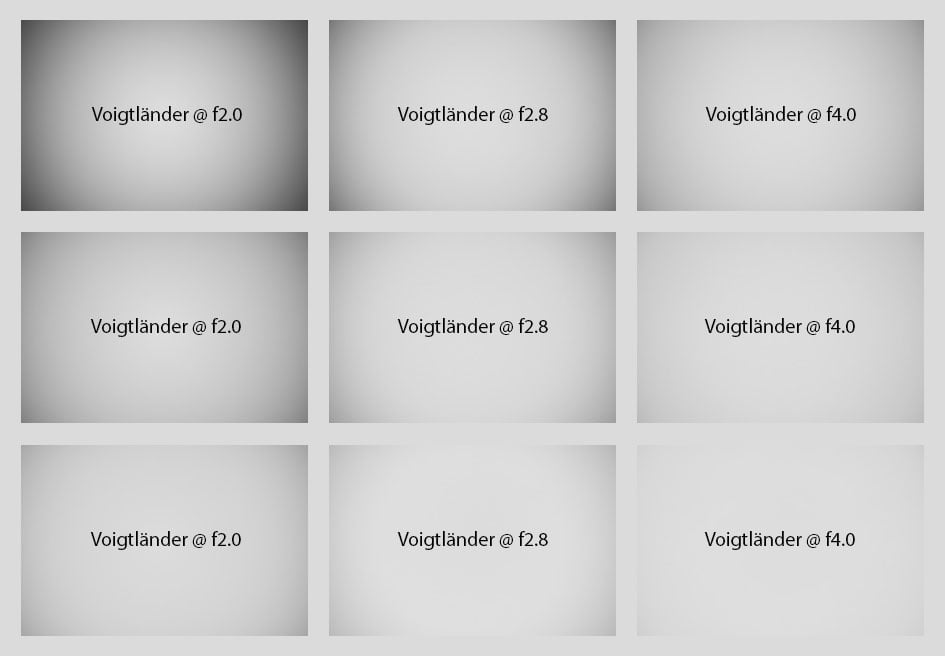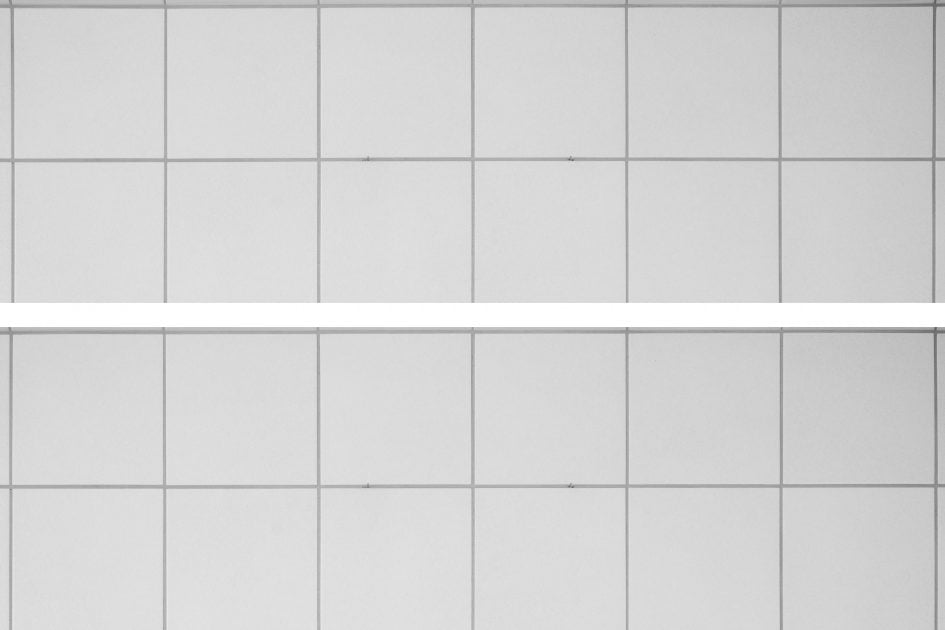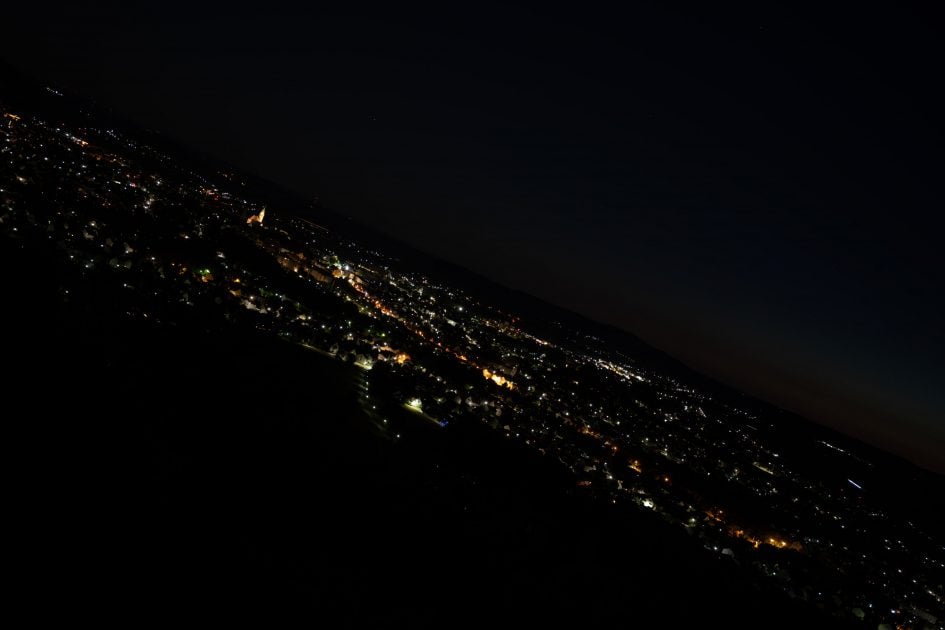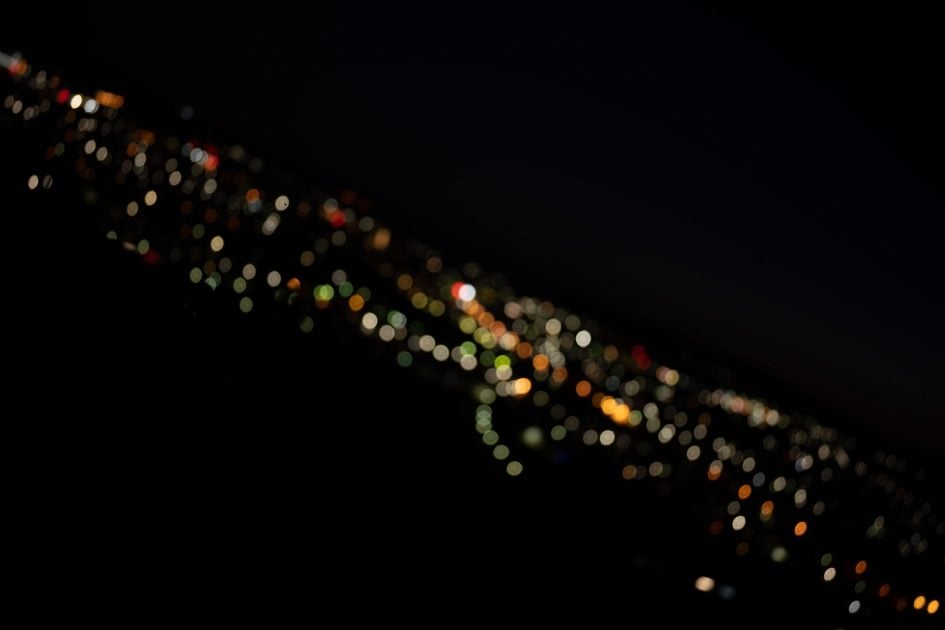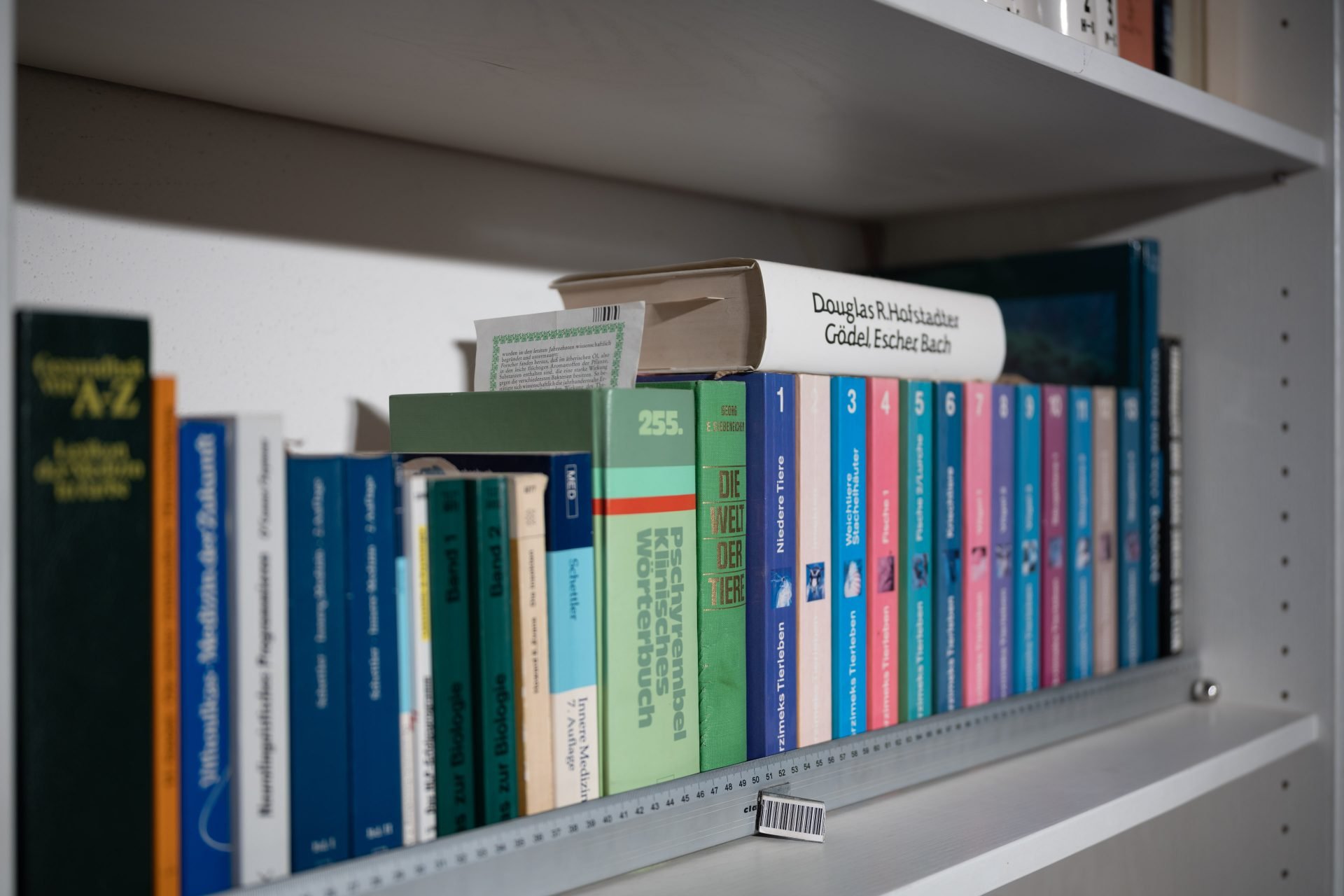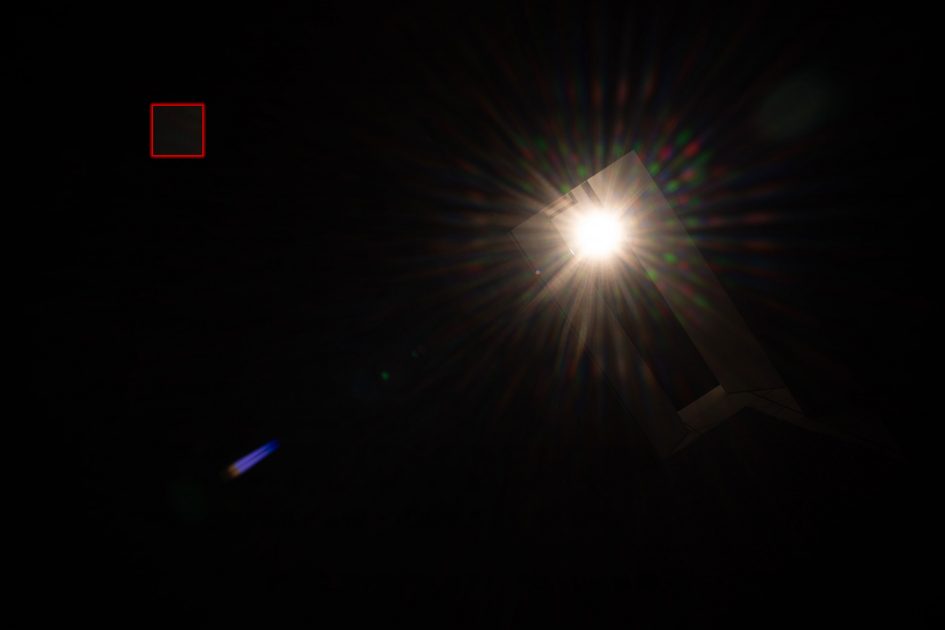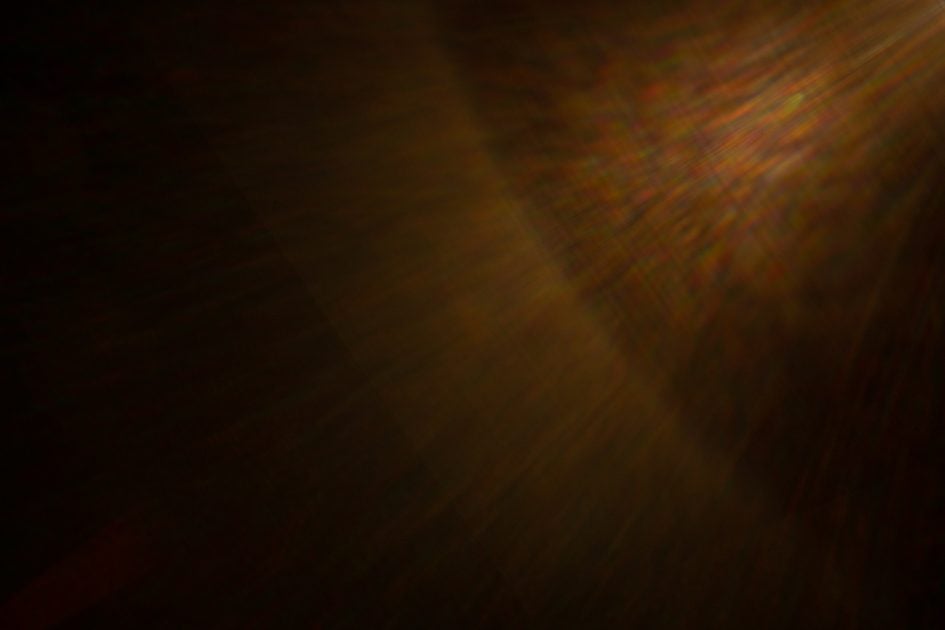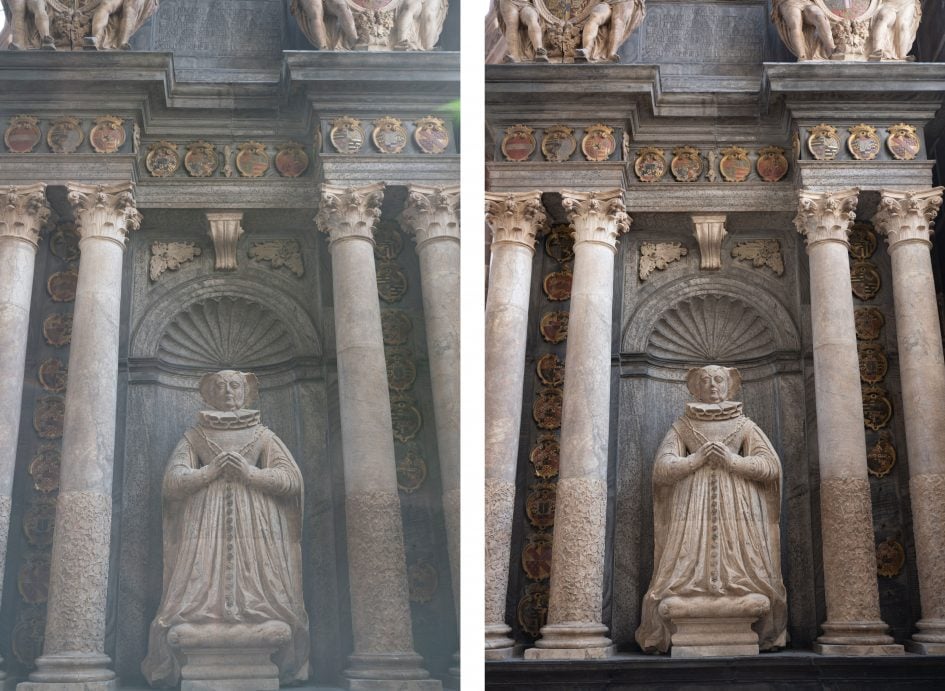Voigtlander 35mm f2 APO-Lanthar review
-
-
Written by Thomas
Quality
Longitudinal Chromatic Aberration and focus shift
Lenses with focal ratios of f2.8 or larger are often prone to longitudinal color aberrations (loCA, a.k.a. “axial color” or “bokeh CA”). These show up as magenta coloration in the foreground and greenish hues in the background and are not easily corrected in post-processing. As an apochromatic design the Voigtländer indeed shows very little loCA. This is (much) better than from the Zeiss Batis, Z-Nikkor, Sony FE or Sigma Art.
Voigtländer 35mm f2 APO-Lanthar Longitudinal Chromatic Aberration (loCA)
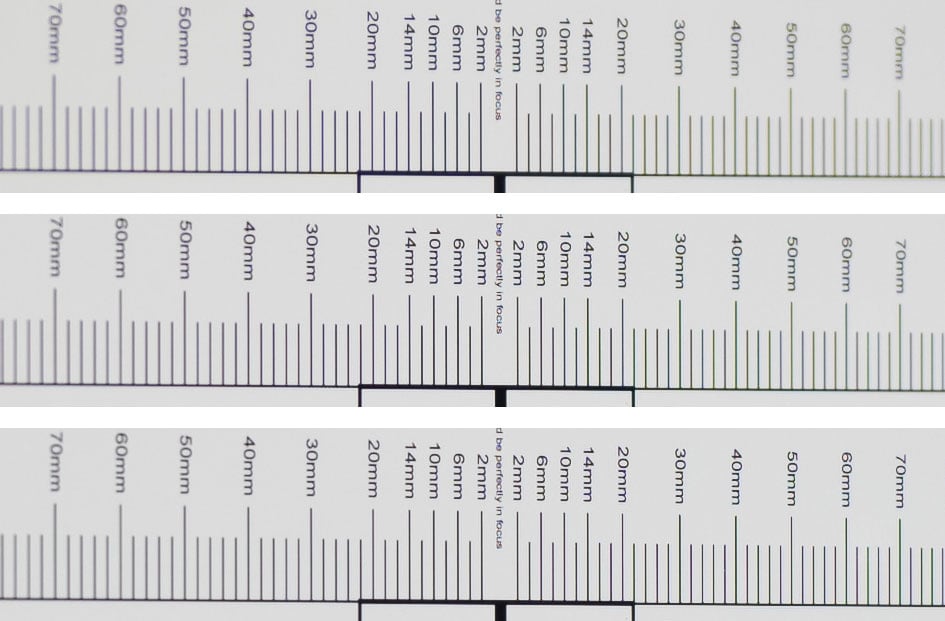
100% crops, from top to bottom: f2.0, f2.8, f4.0; left = foreground, right = background
When stopping down the background becomes sharper much faster than the foreground. I also detected a slight bit of focus shift in my other test-shots. Interestingly on a second copy of the lens only 5 serial numbers apart background and foreground became equally sharper when stopped down.
The following real life shot under harsh contra-light conditions shows that the Voigtländer produces practically no green coloration in the background and very little purple fringing around high-contrast edges in the focus plane. But there’s some spill-over from the extra-bright background into the subjects:
Above: Voigtländer 35mm f2 APO-Lanthar at f2.0; 100% crop; click image to access 4k version, here for large original
Also take a good look at the second image on the samples page of the fountain backlit by the sun: It’s a really tough stress-test and many lenses show colorful artifacts in the air bubbles – but the Voigtländer does not show any. Very good!
Sharpness and contrast
Let’s have a look at the theoretical performance of the Voigtländer 35mm f2 APO-Lanthar and compare it to other mild wide-angle lenses for Nikon Z-mount or Sony E-mount. I’ve added the Viltrox AF 35mm f1.8 which I couldn’t test yet:
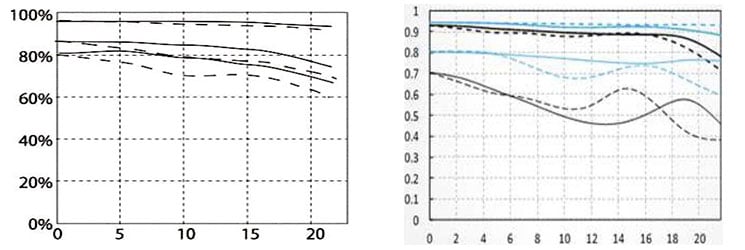
Above: Voigtländer 35mm f2 APO-Lanthar (at f2.0), Viltrox AF 35mm f1.8 (black=f1.8, blue=f8)
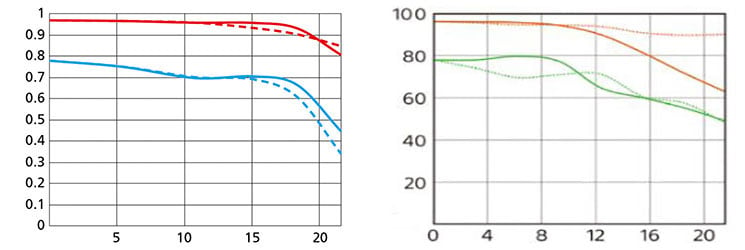
Above: Nikon Z 35mm f1.8 S (at f1.8), Sony FE 35mm f1.8 (at f1.8)
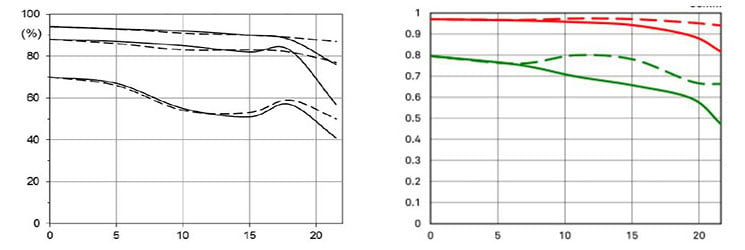
Above: Zeiss Batis 40mm f2 (at f2.0), Sigma 35mm f1.2 DG DN Art (at f1.2)
Voigtländer shows the contrast-curves at 10 line-pairs/mm (top), 30 lp/mm (middle), and 40 lp/mm (bottom). Viltrox, Nikon, Sony and Sigma at 10/30 lp/mm, Zeiss at 10/20/40 lp/mm from top to bottom. Higher values are better (more contrast) and the closer the dotted and solid lines are together the less contrast dependents on the orientation of the test-pattern (less astigmatism). The x-axis displays the distance from the optical axis (=center of the sensor) in mm. I’ll show you the real-life performance at 4 mm (“center”), 13 mm (APS-C/DX-corner), and 20 mm (FF/FX-corner) on a 45MP Nikon Z7 body or 42MP Sony A7R II.
At 10 lp/mm all four lenses look pretty similar on paper and you should not find flaws with overall contrast – with the exception of the Sony FE in the FF-corner where it develops strong astigmatism. But when looking at finer details the Voigtländer pulls ahead: Even at 40 lp/mm it tops the others at 30 lp/mm – even the Sigma 35mm f1.2 DG DN Art. But to be fair: The Sigma has a 1.5 stops brighter focal ratio.
Let’s see how this theoretical performance of the Voigtländer translates into real life results in the sharpness test based on Siemens-stars. Processing was done in Lightroom 11.4.1/CRAW 14.4.1 from RAW to Adobe Color profile with the built-in lens profile applied where available. Noise-reduction is set to 0, sharpening to 50/0.5/36/10, with no extra tone, color, or saturation adjustment. White-balance was adjusted to a neutral white and I did some exposure compensation to make the brightness of all crops match. So you will not see light fall-off in the corners.
The following 100% crops show the Voigtländer 35mm f2 APO-Lanthar from f2.0 down to f11 with only lateral CAs corrected. For comparison I used the Nikon Z 35mm f1.8 S (shot on a Nikon Z7) plus the Sigma 35mm f1.2 Art, Sony FE 35mm f1.8, and Zeiss Batis 40mm f2 all shot on a Sony A7R II. With linear resolution of the 45MP Z7 sensor only 4% higher than from the 42MP A7R II, identical test set-up and identical RAW processing the comparability between the test-shots should be very good.
Voigtländer 35mm f2 APO-Lanthar compared; 100% crop from center, APS-C/DX-corner, FF/FX-corner

Above: Voigtländer 35mm f2 APO-Lanthar at f2.0

Above: Nikon Z 35mm f1.8 S at f2.0

Above: Sigma 35mm f1.2 Art on a Sony A7R II at f2.0

Above: Sony FE 35mm f1.8 on a Sony A7R II at f2.0

Above: Zeiss Batis 40mm f2 on a Sony A7R II at f2.0

Above: Voigtländer 35mm f2 APO-Lanthar at f2.8

Above: Voigtländer 35mm f2 APO-Lanthar at f4.0

Above: Voigtländer 35mm f2 APO-Lanthar at f5.6; also available at f8.0, f11
Wide open the Voigtländer 35mm f2 APO-Lanthar produces very good sharpness in the APS-C/DX image circle with only slightly softer FF/FX corners. The other lenses show similar acuity in the center but the Voigtländer has the sharpest APS-C/DX-corner and also the best FX/FF-corner (with the Zeiss a close second). Regarding field-curvature: It’s negligible within the APS-C/DX image-circle but there’s a little towards the FF/FX-corner. Stopping the lens down softens the center of the Voigtländer a tiny bit due to a slight focus shift.
Performance at long distances
The Siemens-star test-targets are shot at a distance of 45x focal length (i.e. at around 1.6m for 35mm focal length). But performance of lenses also depends on the shooting distance. Therefore I present another series of test-shots of a city around 1 km away. Processing was done in Lightroom 11.4.1/CRAW 14.4.1 from RAW to Adobe Color profile with the built-in lens-profile applied where available. On the Voigtländer I have lateral CAs corrected and I used Adobe’s lens profile to reduce vignetting by 200% at f2.0 and f2.8 and by 100% at smaller apertures. Noise-reduction is set to 0, sharpening to 50/0.5/36/10, with no extra tone, color, or saturation adjustment. I used manual focus at the largest aperture on all lenses in this comparison and did not change focus for other apertures. All shots were made at base ISO and image stabilization switched off.
The following image shows the complete scene wide open to give you an impression of the angle of view. Following the main image are 100% crops from the center, APS-C/DX-corner, and FF/FX-corner from the Voigtländer 35mm f2 APO-Lanthar compared to the Nikon Z 35mm f1.8 S (shot on a Nikon Z7) plus the Sigma 35mm f1.2 Art, Sony FE 35mm f1.8, and Zeiss Batis 40mm f2 all shot on a Sony A7R II. All lenses were shot at different days – but with roughly comparably atmospheric conditions. As usual I have selected the diagonal that provided the better corner results as almost any lens is a bit decentered.
You can access the large originals but please respect our copyright and only use those images for personal use.
Above: Voigtländer 35mm f2 APO-Lanthar at f2.0; click image for 4k version, here for large original

Above: Voigtländer 35mm f2 APO-Lanthar at f2.0; 100% crops, click image for 4k version, here for large original
Above: Nikon Z 35mm f1.8 S at f2.0; 100% crops, click image for 4k version, here for large original
Above: Sigma 35mm f1.2 Art at f2.0 on a Sony A7R II; 100% crops, click image for 4k version, here for large original
Above: Sony FE 35mm f1.8 at f2.0 on a Sony A7R II; 100% crops, click image for 4k version, here for large original
Above: Zeiss Batis 40mm f2 on a Sony A7R II at f2.0; 100% crops, click image for 4k version, here for large original

Above: Voigtländer 35mm f2 APO-Lanthar at f2.8

Above: Voigtländer 35mm f2 APO-Lanthar at f4.0

Above: Voigtländer 35mm f2 APO-Lanthar at f5.6; also available at f8.0, f11
Again the Voigtländer 35mm f2 APO-Lanthar produces a very high level of detail across the full frame already wide open – only matched by the Sigma 35mm f1.2 Art. Stopping the Voigtländer down to f2.8 visibly reduces vignetting but otherwise does little to improve acuity any further.
Vignetting and distortions
To make it easier to see light fall-off in the corners of a full-frame sensor I’ve arranged a series of shots with the Voigtländer 35mm f2 APO-Lanthar at different apertures. All images were developed from RAW to the same brightness in the center. As the Voigtländer lens does not come with an integrated lens profile the JPGs straight out of camera are not influenced by the setting for vignette control (or auto distortion control) in camera.
Above from top to bottom: Voigtländer 35mm f2 APO-Lanthar w/o lens profile, with Adobe lens profile at 100%, with Adobe lens profile at 200%
The sample images above show that without lens profile vignetting of the Voigtländer is very strong wide open and still very visible at f2.8. At f2.0 Adobe’s lens profile set to 100% lifts the extreme corners about 1.0 EV and about 1.6 EV when set to 200%.
Distortions are of a mild but wavy pin-cushion type and are pretty well corrected with Adobe’s lens profile:
Voigtländer 35mm f2 APO-Lanthar: RAW without distortion compensation (top), RAW with distortion compensation from Adobe’s lens-profile at 100% (bottom)
Rendering of point-light sources at night-shots
Night-shots pose a different challenge for lenses as the contrast is even higher than under bright sun and point-light sources can reveal some weaknesses such as coma, haloing and colour-aberrations that do not show up as prominently in other test-shots. The 100% crops below the main image show the effect of coma in the FF/FX-corner of the Voigtländer at various apertures:
Above: Voigtländer 35mm f2 APO-Lanthar at f2.0; click image for 4k version, here for large original

Above: Voigtländer 35mm f2 APO-Lanthar; 100% crops from the FF/FX-corner at f2.0 (left), f2.8 (middle), f4.0 (right)
The Voigtländer 35mm f2 APO-Lanthar shows very little coma at f2 and f2.8. From f4.0 onwards the lens produces more diffraction spikes than coma.
Bokeh quality
This test is for the rendering of point-light sources in an out-of-focus background. The circle of confusion that is produced by this test is pretty indicative of Bokeh performance (in the background) and light fall-off. Ideally the out-of-focus image of the point-light is evenly lit and perfectly circular, with no “onion-rings”, and without coloration. Large aperture lenses normally produce an effect known as “cat’s eye” the further away from the optical axis the point-light is projected. This is due to optical vignetting in the lens barrel when light enters the lens from an angle.
The crops below the main image are from the center, APS-C/DX-corner, and FF/FX-corner of the 4k version. These shots are not corrected for light fall-off.
Above: Voigtländer 35mm f2 APO-Lanthar at f2.0; click image for 4k version
Above: Voigtländer 35mm f2 APO-Lanthar at f2.0; click image for 100% crops
Above: Voigtländer 35mm f2 APO-Lanthar at f2.8; click image for 100% crops
Above: Voigtländer 35mm f2 APO-Lanthar at f4.0; click image for 100% crops
The diameter of the Bokeh balls in the center is determined by the entrance pupil of the lens: Thus the Voigtländer produces slightly smaller Bokeh balls than a 35mm f1.8 lens (at identical magnification). Wide open the Voigtländer produces Bokeh balls which are free of an outline but show two brighter rings inside. Coloration from loCA is absent but cat’s eye effect towards the corners is clearly visible even in the APS-C/DX-corner at f2.0 and still visible at f2.8. The aperture blades of the Voigtländer are perfectly rounded at f2.0 and f2.8 but at other apertures the aperture blades show up in the circles of confusion. Although to be fair: twelve aperture blades make for a nicer approximation of a circle than seven or nine.
Now let’s see how this analysis of out-of-focus point-light sources translates into Bokeh-performance shooting a book-shelf. Again, the crops of the foreground, the middle-ground, and the background below the main image are resized to make them comparable across all my reviews. The Voigtländer was corrected for distortions and light fall-off.
Above: Voigtländer 35mm f2 APO-Lanthar at f2.0; click image for 4k version, here for large original
Above: Voigtländer 35mm f2.0 APO-Lanthar at f2.0; click image for 4k version, here for large original
Above: Nikon Z 35mm f1.8 S at f1.8; click image for 4k version, here for large original
Above: Sigma 35mm f1.2 Art at f1.2; click image for 4k version, here for large original
Above: Sony FE 35mm f1.8 at f1.8; click image for 4k version, here for large original
Above: Zeiss Batis 40mm f2 at f2.0; click image for 4k version, here for large original
Clearly the Bokeh of the Sigma 35mm f1.2 Art obliterates all other lenses. But comparing the lenses with focal ratios of f1.8 or f2.0 it becomes clear that the Voigtländer offers the softest Bokeh with a smooth and laCO-free transition zone in the middle-ground and the least nervous background.
Looking at another crop (now at 100%) from the same images showing the ruler the Voigtländer shows the least tendency for double contours of all the lenses – even the Sigma 35mm f1.2 Art.
Above: Voigtländer 35mm f2.0 APO-Lanthar at f2.0; click image for 4k version, here for large original
Above: Nikon Z 35mm f1.8 S at f1.8; click image for 4k version, here for large original
Above: Sigma 35mm f1.2 Art at f1.2; click image for 4k version, here for large original
Above: Sony FE 35mm f1.8 at f1.8; click image for 4k version, here for large original
Above: Zeiss Batis 40mm f2 at f2.0; click image for 4k version, here for large original
Out of curiosity I’ve added the respective crops from the Sigma 35mm f1.2 Art shot at f2.0. Differences between the Sigma and the Voigtländer are now minimal with the Sigma rendering a smoother foreground and the Voigtländer having a slight advantage in the transition zone.
Above: Sigma 35mm f1.2 Art at f2.0; click image for 4k version
Above: Sigma 35mm f1.2 Art at f2.0; click image for 4k version
Close-up performance
The Voigtländer 35mm f2.0 APO-Lanthar achieves a maximum magnification of 1:6.6 at minimum object distance. The following images were shot at 1:6.7 where the area of sharp focus is just 160 x 240mm. The images shown below are 100% crops from 0mm, 11mm, and 19mm off the center of the sensor respectively. The shots were not corrected for distortions or light fall-off.
Voigtländer 35mm f2.0 APO-Lanthar; 100% crop from center, APS-C/DX-corner, FF/FX-corner

Above: Voigtländer 35mm f2.0 APO-Lanthar at f2.0; 100% crops

Above: Voigtländer 35mm f2.0 APO-Lanthar at f2.8; 100% crops

Above: Voigtländer 35mm f2.0 APO-Lanthar at f4.0; 100% crops
The Voigtländer 35mm f2.0 APO-Lanthar is already quite sharp at f2.0 even in the outer image area and stopping down to f4.0 yields very sharp results across the full frame. Field curvature is negligible even at minimum object distance.
Flare, glare, ghosting, and sun-stars
Catching a strong light-source shining directly into the lens is always a risky business: it could produce strange colorful ghost-images or reduce contrast considerably through flare and glare. The appearance of flare and ghosting depends on factors like the aperture and the angle of the light hitting the lens. So to judge the proclivity of the Voigtländer 35mm f2 APO-Lanthar for these artifacts I went through a series of well calculated shots against a strong light source to provoke glare and ghosting. The lens hood was mounted in all shots. Following are some of the more extreme example results. The little bright square inset in the upper left shows the respective area with an exposure compensation of +3 EV to make it easier to see which levels of black the lens renders at that point:
Above: Voigtländer 35mm f2 APO-Lanthar at f16; click image for 4k version or here for +3 EV exposure compensation
Under normal circumstances the Voigtländer does produce a bit of flare, glare and ghosting especially when the light-source is close to the center, but the images keep a very deep black outside the immediately affected areas.
But there is a position well outside the FF/FX-corner where the sun can cause strong veiling glare. I had a glimpse of this effect in my test-shot below but that is with an exposure compensation of +3 EV:
Above: Voigtländer 35mm f2 APO-Lanthar at f16 with +3 EV exposure compensation; click image for 4k version
In the following example the sun was shining from high above through a window and caused a very visible degradation in contrast (left image). I only had to step back a bit into the shadow to get rid of the problem (right). One has to keep in mind though that it was +8 EV brighter outside than where the statue stood.
Above: Voigtländer 35mm f2 APO-Lanthar at f2; click image for 4k version
The Voigtländer 35mm f2 APO-Lanthar has 12 intricately curved aperture blades: The aperture is perfectly circular at f2.0, f2.8, f5.6 and f16 and thus does not produce sunstars at those settings. But at every other aperture (even at f2.2) the lens produces 12 diffraction spikes which are more or less well defined depending on the aperture. This is a pretty unique feature.
Above: Sunstars from the Voigtländer 35mm f2 APO-Lanthar, click image for 100% crops
Next check out my sample images!
Check prices on the Voigtlander 35mm f2 APO-Lanthar at B&H, Adorama, WEX UK or Calumet.de. Alternatively get yourself a copy of my In Camera book, an official Cameralabs T-shirt or mug, or treat me to a coffee! Thanks!
